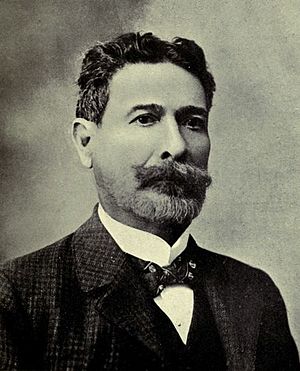Fernando Figueroa facts for kids
Quick facts for kids
Brigadier General
Fernando Figueroa
|
|
|---|---|
 |
|
| 23rd President of El Salvador | |
| In office 1 March 1907 – 1 March 1911 |
|
| Vice President | Manuel Enrique Araujo |
| Preceded by | Tomás Regalado |
| Succeeded by | Manuel Enrique Araujo |
| In office 14 May 1885 – 18 June 1885 Provisional President |
|
| Preceded by | Rafael Zaldívar |
| Succeeded by | José Rosales Herrador |
| Minister of National Defense | |
| In office 11 July 1906 – 1 March 1911 |
|
| President | Pedro José Escalón (1906–1907) Himself (1907–1911) |
| Preceded by | Tomás Regalado |
| Succeeded by | José María Peralta Lagos |
| In office 1 March 1900 – 1 March 1903 |
|
| President | Tomás Regalado |
| Preceded by | Position established |
| Succeeded by | Tomás Regalado |
| Personal details | |
| Born | 4 March 1849 Ilobasco or San Vicente, El Salvador |
| Died | 16 June 1919 (aged 70) San Salvador, El Salvador |
| Political party | Liberal |
| Spouse |
Luz Rodríguez
(m. 1878) |
| Children | 6 |
| Occupation | Military, politician |
| Military service | |
| Allegiance | |
| Branch/service | Salvadoran Army |
| Years of service | 1863–1885, 1890–1911 |
| Rank | Brigadier General |
| Battles/wars | War of 1863 Barrios' War of Reunification Second Totoposte War Third Totoposte War War of 1907 |
Fernando Figueroa (born March 4, 1849 – died June 16, 1919) was an important leader in El Salvador. He served as the President of El Salvador two times. His first time was for a short period in 1885, and his second term was from 1907 to 1911. He also held the position of Minister of National Defense and was a governor in the San Vicente area.
Contents
Early Life and Family
Fernando Figueroa was born on March 4, 1849, in El Salvador. He was born in either Ilobasco or San Vicente. In 1878, he married Luz Rodríguez. They had six children together: three daughters and three sons.
Military Career
Figueroa began his military career in 1863. He joined the Salvadoran Army during a conflict known as the War of 1863 against Guatemala. He was a brave soldier and was promoted to Lieutenant. Even though his side lost the war, he was still promoted to Captain later on.
He fought in wars against Honduras three times, in 1871, 1872, and 1873. In 1873, he became the Governor of San Vicente. By 1876, he was promoted to the rank of General. He was put in charge of the government's forces during a major conflict called the Barrios' War of Reunification.
First Time as President
Fernando Figueroa became the Provisional President of El Salvador on May 14, 1885. This happened after the previous president, Rafael Zaldívar, resigned. A provisional president is someone who takes charge for a short time until a new leader is officially chosen. Figueroa served in this role until June 18, 1885, when he stepped down. He was then replaced by José Rosales Herrador. After this, Figueroa took a break from politics.
Between Presidencies
Figueroa returned to public life in 1890. President Carlos Ezeta appointed him as Governor of San Vicente again. Later, in 1900, President Tomás Regalado made him the Minister of National Defense. This meant he was in charge of the country's military forces.
Second Time as President
Figueroa was elected President of El Salvador for a second time in 1907. He officially took office on March 1, 1907. During his second term, El Salvador faced a war in 1907. This war involved Honduras, Nicaragua, and some Salvadoran rebels. The President of Nicaragua, José Santos Zelaya, led the invasion.
On June 11, 1907, President Figueroa gave a speech to the people of El Salvador. He asked the army and all citizens to stay loyal and fight against the invasion. Other countries spoke out against the invasion. The United States helped to end the war through talks. A peace treaty was signed on December 20, 1907, in Washington, D.C..
His second term as president ended on March 1, 1911. His Vice President, Manuel Enrique Araujo, took over as the next president. Figueroa was the last military leader to be president of El Salvador for a long time. The next military president was Maximiliano Hernández Martínez in 1931.
Death
Fernando Figueroa passed away on June 16, 1919.
See also
 In Spanish: Fernando Figueroa para niños
In Spanish: Fernando Figueroa para niños

